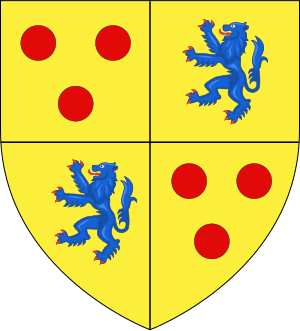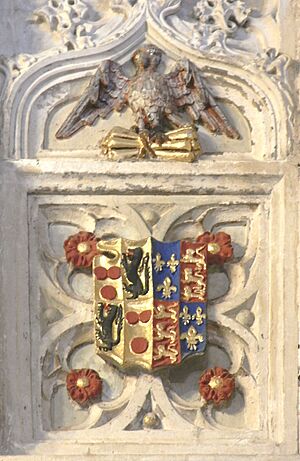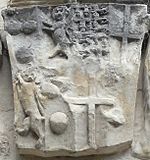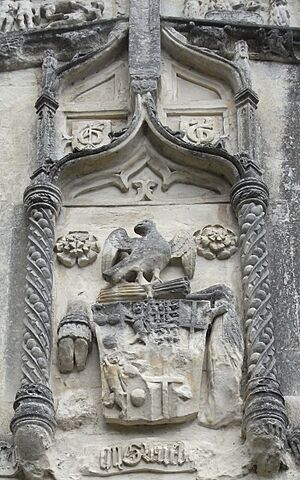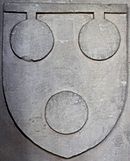William Courtenay, 1st Earl of Devon facts for kids
William Courtenay, 1st Earl of Devon (born 1475 – died 9 June 1511) was an important noble from Devon, England. He was a leader of one of the most powerful families in the area. His main home was Tiverton Castle in Devon, and he also had homes at Okehampton Castle and Colcombe Castle.
Contents
Family Background
William Courtenay was the son of Edward Courtenay, 1st Earl of Devon. His mother was Elizabeth Courtenay. William's parents were distant cousins, meaning they shared some of the same ancestors. Their family had been important in Devon for many years.
His Life and Work
William Courtenay supported King Henry VII, who was the first king from the Tudor family. In 1487, King Henry VII made William a knight. This was a special honor given at the coronation of Queen Elizabeth.
William also served as a Captain in the king's army. He helped his father defeat a man named Perkin Warbeck in 1497. Warbeck was a "pretender," meaning he pretended to be a prince and tried to take the throne. William's help in defeating Warbeck made sure the Tudor family stayed in power.
Trouble with the King
Later, William Courtenay got into trouble with King Henry VII. The king found out that William had joined a secret plan. This plan was to make Edmund de la Pole, 3rd Duke of Suffolk king instead. Edmund was the last person who could claim the throne from the York family, who had ruled before the Tudors.
Because of this, King Henry VII put William in the Tower of London in 1504. He also took away William's right to inherit his family's lands and titles. This meant William could not become an Earl.
Freedom and New Beginnings
When King Henry VII died, his son Henry VIII became king in 1509. King Henry VIII released William Courtenay from prison. William was given back his rights and special privileges. He even carried a sword at King Henry VIII's coronation ceremony.
Some people debate if William officially got back his full title as Earl before he died. However, some records say he did get back his titles and lands in May 1511. This happened after he took part in a jousting tournament with the new king.
Marriage and Children
In 1495, William Courtenay married Catherine of York. She was the sixth daughter of King Edward IV and Queen Elizabeth Woodville. Catherine was also the sister of the Queen at the time, Elizabeth of York.
William and Catherine had three children:
- Henry Courtenay, 1st Marquess of Exeter (born around 1496 – died 1539). He married two times.
- Lady Margaret Courtenay (born around 1499 – died before 1526). She married Henry Somerset, 2nd Earl of Worcester.
- Edward Courtenay (born 1497 – died 1502).
A Special Monument
In Colyton Church in Devon, there is a small statue. People traditionally say it is "little choke-a-bone," who was Margaret Courtenay. She was said to be an infant daughter of William Courtenay and Princess Catherine of York. The story says she died in 1512 after choking on a fish-bone at Colcombe Castle. The statue is only about three feet long, which is much smaller than a statue of an adult.
A brass sign above the statue says: "Margaret, daughter of William Courtenay Earl of Devon and the Princess Katharine youngest daughter of Edward IVth King of England, died at Colcombe choked by a fish-bone AD MDXII and was buried under the window in the north transept of this church."
However, records show that a daughter named Margaret was still alive in 1520. She was serving Princess Mary Tudor, who was King Henry VIII's daughter. It's possible that the family had two daughters named Margaret, which was sometimes done in those days.
Family Shields on the Monument
Above the small statue, there are three carved shields. These shields show the family symbols, called "arms." They show the Courtenay family arms, the Courtenay arms combined with the royal arms of England, and the royal arms of England by themselves.
These shields help historians try to figure out who the statue really represents. Some experts now think the statue might be for Lady Margaret Beaufort. She was the wife of an earlier Earl of Devon, Thomas Courtenay. This is because the "royal arms" shown might actually be the arms of the Beaufort family, which were similar to the royal arms but with a special border.
Death and Burial
William Courtenay died from a lung illness called pleurisy on 9 June 1511. He was buried in Blackfriars, London, a church in London, with special permission from the king.


